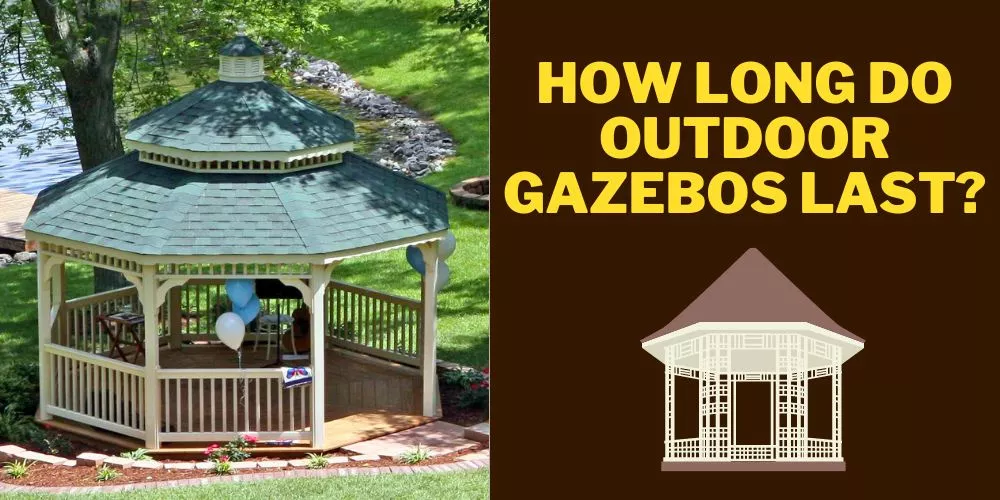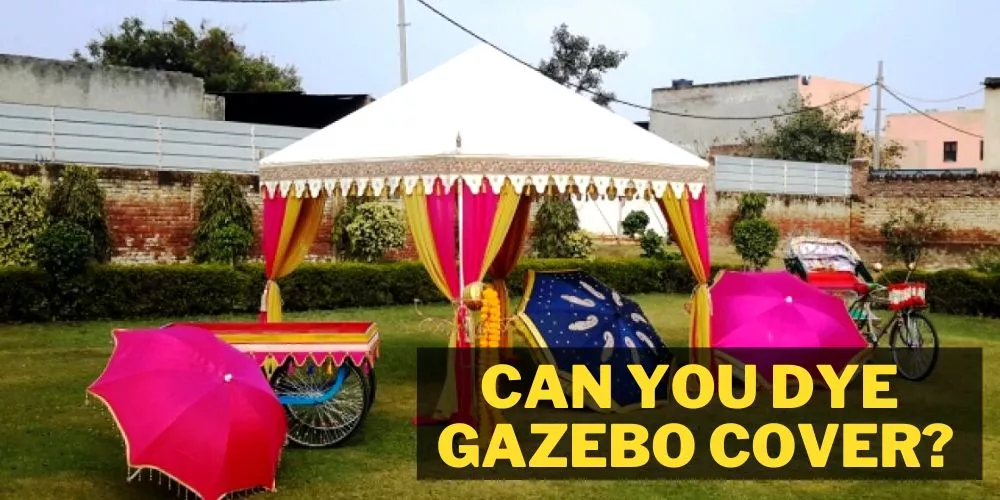Gazebos stand as elegant centrepieces in your garden, blending charm with function. But amidst changing seasons and weather’s whimsy, one question lingers: How long do gazebos last?
In this article, we’ll delve into the lifespan of these backyard beauties, exploring materials, maintenance, and tips to ensure your gazebo remains a timeless retreat for years to come.Join us as we uncover the secrets to maximizing your gazebo’s longevity.
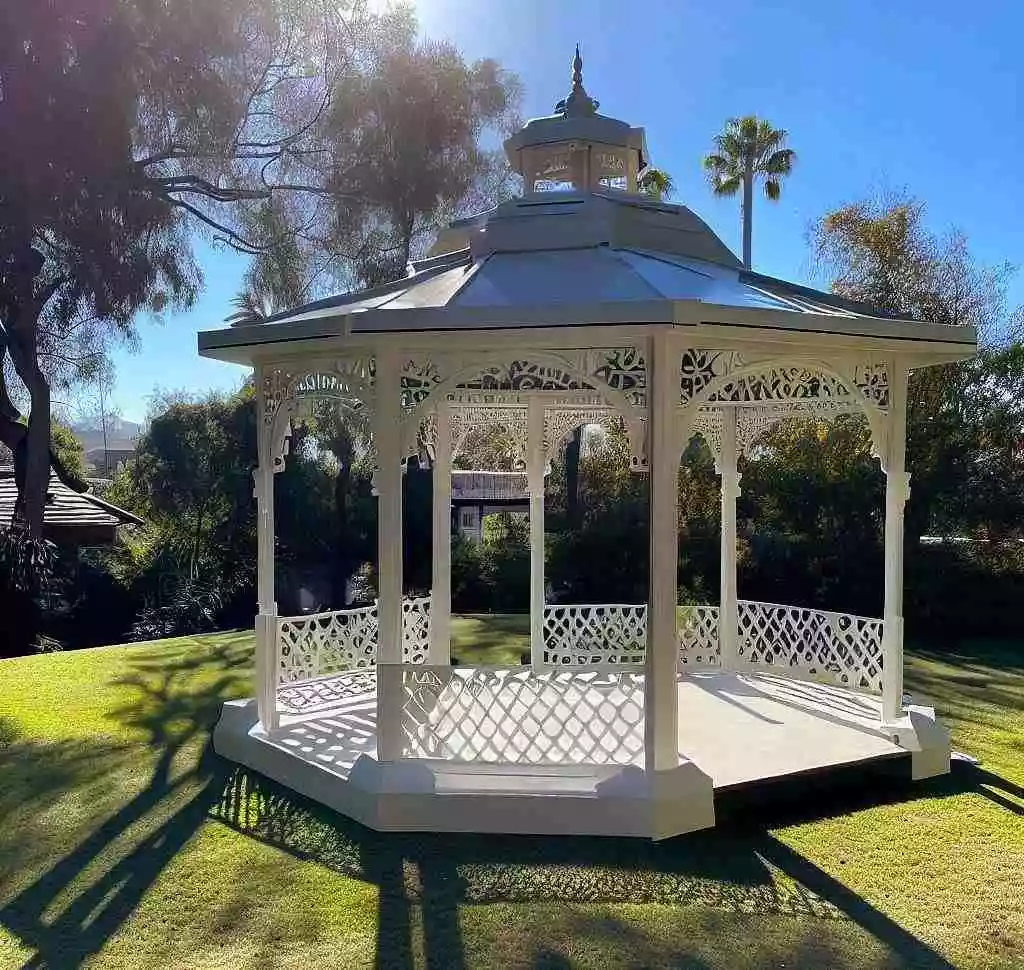
How Long Do Gazebos Last?
The answer isn’t quite straightforward as it hinges on numerous factors we’ve previously discussed, like material quality, regular maintenance, and local climate. However, to give a generalized answer, gazebos can last 10 to 20 years or even longer with the right care. Now, let’s delve deeper into the lifespans of different types of gazebos.
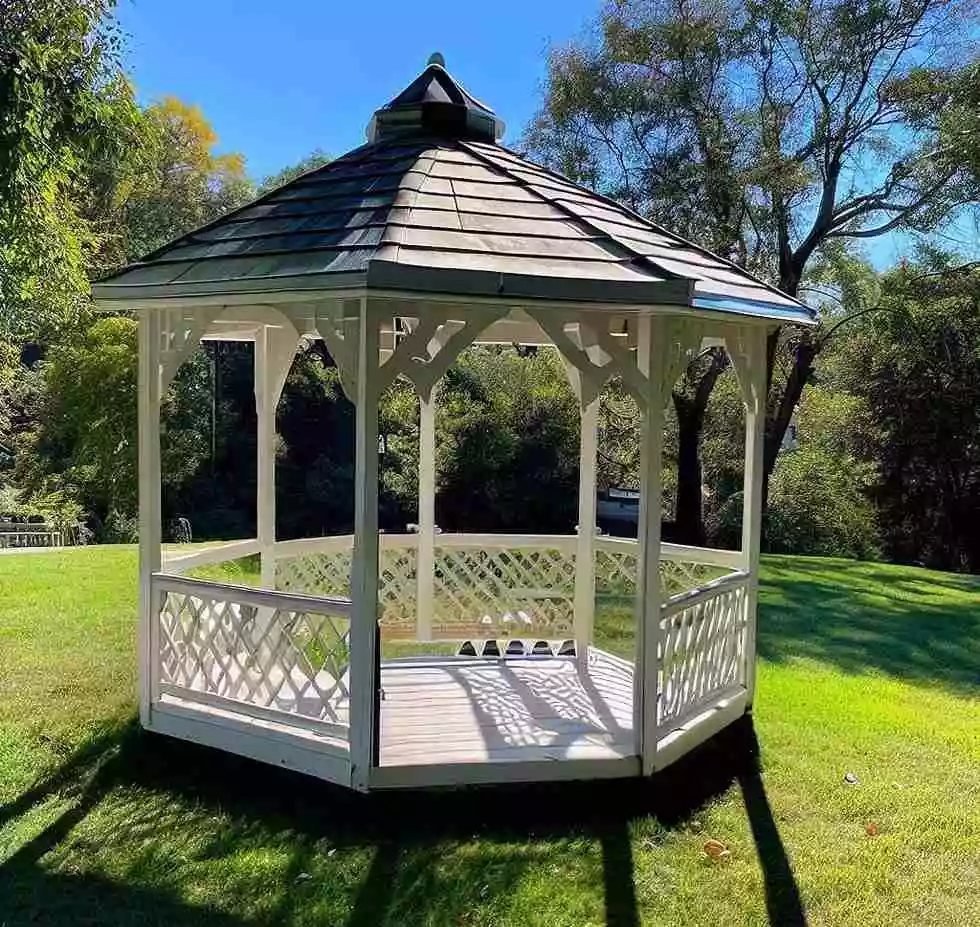
Average Lifespan of Different Types of Gazebos
The material from which a gazebo is made significantly impacts its lifespan. In the following sections, we’ll explore the longevity of wood, metal, and vinyl gazebos and factors that can affect their durability.
1. Wood Gazebos
Wooden gazebos are a classic choice for those who value traditional aesthetics and a natural, inviting ambiance in their outdoor space. But when it comes to longevity, what can you expect from a wood gazebo?
Generally speaking, a well-crafted and properly maintained wooden gazebo can last 10 to 20 years, and in some cases, even longer. It’s worth noting that this lifespan is not set in stone, as several factors can influence it.
Firstly, the type of wood used in constructing the gazebo significantly determines its lifespan. Hardwoods like cedar, teak, and redwood are naturally resistant to decay and insect infestations, attributes that can extend a gazebo’s life. Cedar, for instance, contains natural oils that act as a preservative, giving it a lifespan of up to 15 to 20 years or more.
While more cost-efficient, softwoods like pine typically have a shorter lifespan due to their susceptibility to rot and pests. However, when pressure-treated, these woods can resist decay for a longer time, potentially matching the lifespan of some hardwoods.
Secondly, the maintenance of your wooden gazebo is crucial to its longevity. Regular cleaning to remove dirt, debris, and mildew helps preserve the wood. It’s also essential to routinely check for rot or pest infestation signs and treat them promptly. Wood sealants and stains enhance the gazebo’s aesthetic appeal and provide a protective layer against weather elements, extending its life.
Lastly, the environmental conditions where the gazebo is situated can affect its durability. A gazebo exposed to severe weather conditions like heavy rain, strong winds, or intense sunlight will require more maintenance than one in a mild climate.
2. Metal Gazebos
Regarding longevity, metal gazebos stand out as a top choice. Their sleek modern aesthetics and durability make them a popular option for many homeowners. But just how long can you expect a metal gazebo to last?
Typically, a well-maintained metal gazebo can serve you well for 15-20 years. This lifespan, however, can be significantly extended with the proper care and attention.
The type of metal used in your gazebo’s construction is critical in its lifespan. For instance, with their robust build, steel gazebos are incredibly sturdy and can withstand harsh weather conditions, enhancing their durability. Yet, they are prone to rust if their protective coating gets damaged, which could reduce their longevity.
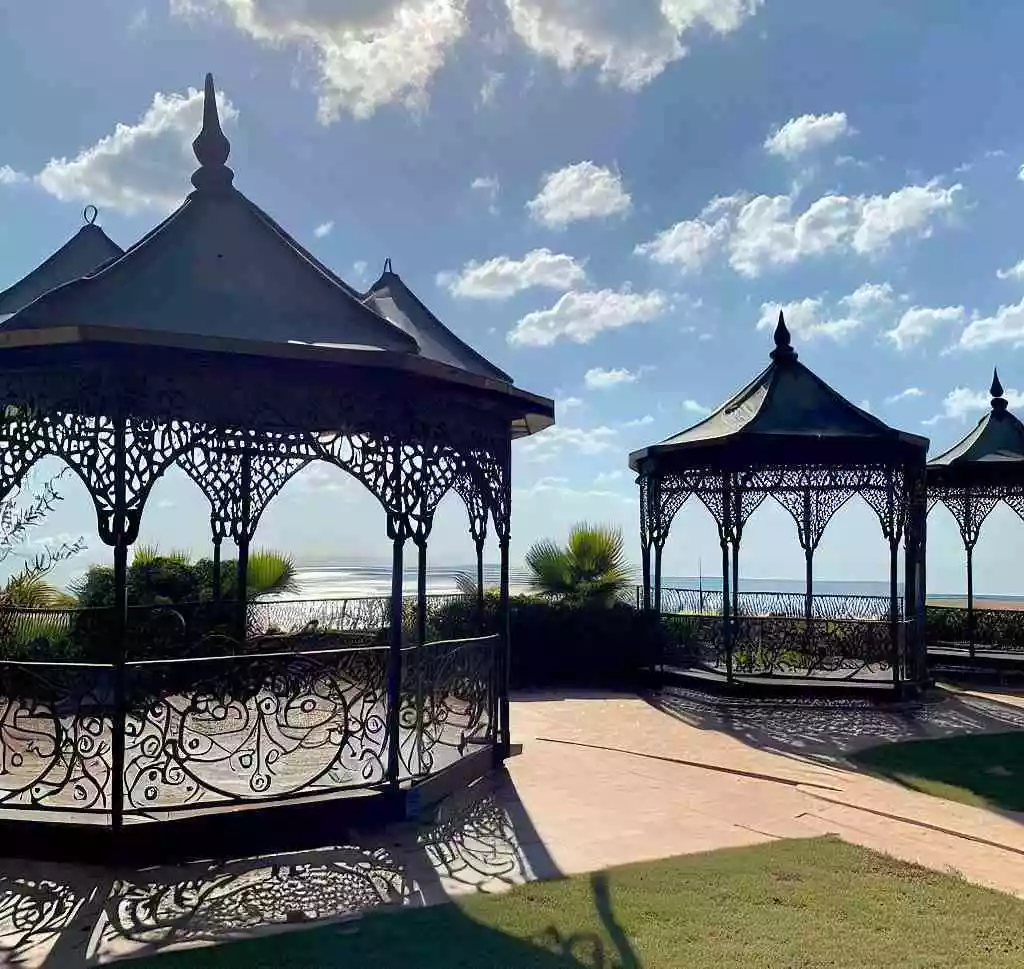
On the other hand, aluminum gazebos are rust-resistant, making them ideal for humid climates. They are lighter and might require additional anchoring to withstand strong winds. Despite this, their hassle-free maintenance can contribute to a longer lifespan.
Maintenance is vital to prolong the life of your metal gazebo. Regular inspections to spot early signs of wear and tear or rust can help you address these issues promptly. If you notice any rusting on your steel gazebo, treating it early can prevent further deterioration. Applying a rust-resistant coating can also safeguard against future rusting.
Cleaning your gazebo regularly helps maintain its aesthetic appeal and prevents the buildup of dirt and grime that could damage its protective coating over time. It’s important to use a gentle cleaning solution and avoid abrasive tools that might scratch or damage the surface.
Additionally, during adverse weather conditions like high winds or heavy snowfall, consider using a gazebo cover or removing any detachable parts to prevent damage.
3. Vinyl Gazebos
Vinyl gazebos bring together the best of both worlds – the elegance of traditional designs and the hassle-free maintenance of modern materials. If you’re considering installing a vinyl gazebo, you might wonder about its lifespan and maintenance.
In terms of longevity, vinyl gazebos are tough competitors. Thanks to their robust and resilient nature, they often last between 20 to 25 years, sometimes even longer. But as with any outdoor structure, variations in lifespan can be expected due to several factors.
The quality of the vinyl used in your gazebo’s construction can greatly impact its durability. Premium, high-quality vinyl is typically UV-resistant, which prevents it from becoming brittle or fading due to prolonged sun exposure. In contrast, lower-quality vinyl might not withstand harsh weather conditions as effectively, leading to a shorter lifespan.
As for maintenance, one of the significant advantages of vinyl gazebos is that they require minimal upkeep. They resist rot and insects, eliminating the need for treatments or coatings. Still, regular cleaning is necessary to keep your gazebo looking its best. A gentle soap solution and a soft brush can remove dirt and grime without damaging the surface.
Periodic inspections are also recommended to spot any potential issues. For instance, although vinyl is generally sturdy, heavy winds or harsh weather can cause damage. Identifying and addressing these problems early can prevent significant damage and extend your gazebo’s life.
In addition, if your vinyl gazebo comes with a roof made from a different material like asphalt shingles or wooden planks, remember to maintain these areas. Regular roof inspections and repairs, as needed, will help keep your gazebo in top condition.
How to Extend the Lifespan of Gazebos?
Regardless of their material composition, Gazebos require attention and care to ensure they last. But how can you actively contribute to your gazebo’s lifespan extension? Let’s break it down into three primary areas: structure upgrades, regular maintenance, and weather protection.

Upgrading and Reinforcing Structures
Structural upgrades and reinforcements are an effective strategy to enhance your gazebo’s durability and longevity.
Additional supports and reinforcements
Adding extra supports to your gazebo can boost its stability and resistance to wind damage, especially for lightweight structures. This can involve fortifying existing pillars, adding new cross beams, or integrating diagonal bracing to enhance structural integrity. These enhancements can greatly increase the lifespan of your gazebo, especially if it is regularly exposed to harsh weather conditions.
Upgrading materials or components
Sometimes, replacing certain components with more durable alternatives is the key to extending your gazebo’s life. This could be substituting a softwood pillar with a hardwood equivalent or replacing a fabric roof with a sturdier metal or polycarbonate one. Upgrades should be considered based on your gazebo’s weaknesses or areas prone to rapid wear and tear.
Regular Maintenance Schedule
Maintenance is crucial to the longevity of your gazebo, and having a regular schedule can make it less of a daunting task.
Cleaning and treating the gazebo
Whether it’s wood, metal, or vinyl, regular cleaning helps prevent buildup of dirt, grime, and organic materials that can lead to issues like mold or corrosion. For wooden gazebos, periodic treatment with a sealant or wood preservative is essential to protect against decay and insect infestation.
Inspecting for structural issues
It’s important to frequently check your gazebo for signs of structural problems. Look out for cracks, rot, rust, loose screws, or any other indications of damage. Early detection and prompt repair can prevent minor issues from escalating into major problems that can shorten your gazebo’s life.
Weather Protection Measures
Protecting your gazebo from adverse weather conditions can greatly prolong its life.
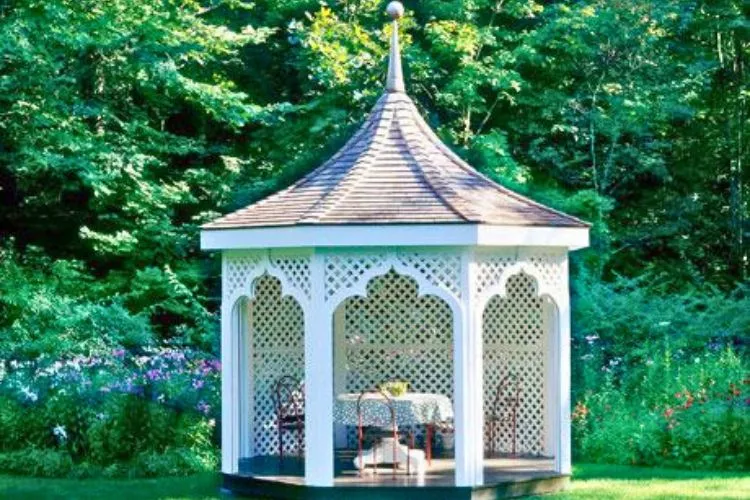
Using covers or canopies
Gazebo covers or canopies can protect your structure from sun, rain, and snow. These covers come in different materials, offering varying levels of protection. When selecting a cover, consider your local climate and choose one that can withstand the common weather conditions in your area.
Anchoring techniques for wind resistance
Wind can be a significant threat to your gazebo’s lifespan. Anchoring your gazebo firmly to its base will increase its resistance to wind damage. This can be done using various methods, such as anchor kits, heavy-duty stakes, or attaching it to a permanent base like a concrete slab.
You might also want to know before Buying a Gazebo: Can a gazebo withstand heavy rain? | Can a gazebo handle snow?
Frequently Asked Questions (FAQs)
How often should I inspect my gazebo for damage?
Ideally, you should inspect your gazebo for any potential damage or wear every three months. However, it’s advisable to conduct an immediate check after extreme weather conditions.
Can I repaint or restain my wooden gazebo?
You can repaint or restain your wooden gazebo. Doing so every 1-2 years will keep it looking fresh and provide extra protection against weather elements.
Are there any specific maintenance considerations for coastal areas?
For coastal areas, use rust-resistant metals or treated wood. Regularly clean and check for salt and moisture damage. Applying anti-corrosion paint or sealant can also help prolong the lifespan.
What should I do if my metal gazebo develops rust?
If your metal gazebo develops rust, start by scrubbing off the rust with a wire brush. Afterward, apply a rust converter and finish with a coat of rust-resistant paint.
Conclusion:
We’ve explored the world of gazebos in detail, highlighting how materials, maintenance practices, and the local climate influence their lifespans.
We’ve discovered that wood, metal, and vinyl gazebos have unique strengths and longevity factors, while reinforcing structures, regular upkeep, and protective measures are key to a gazebo’s extended lifespan.
But remember, knowing is only half the battle – implementing these strategies is what will truly make the difference. So, leap, and let’s ensure your gazebo lasts a lifetime.

